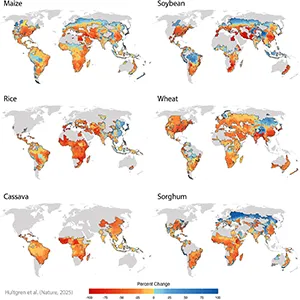IFAD Calls for Urgent Investment in Rural People and Small-Scale Farmers to Transform Global Food Systems – fanamc.com

Report on IFAD’s Call to Action at the UN Food Systems Summit +4 Stocktaking Moment
Introduction: Aligning Global Food Systems with the Sustainable Development Goals
During the UN Food Systems Summit +4 Stocktaking Moment in Addis Ababa, the International Fund for Agricultural Development (IFAD) presented a formal call for urgent action. The report emphasizes the necessity of restructuring global food systems by prioritizing rural communities and small-scale farmers, a strategy deemed essential for achieving the Sustainable Development Goals (SDGs).
The Critical Role of Small-Scale Producers in Achieving SDG 2 (Zero Hunger)
IFAD President Alvaro Lario underscored the indispensable contribution of small-scale food producers to global food security. Investment in this sector is presented as the most direct pathway to achieving SDG 2 and related development targets.
- Small-scale farmers, particularly women and youth, are responsible for producing up to one-third of the world’s food.
- Supporting these producers is fundamental to building food systems capable of feeding the global population, providing decent work (SDG 8), and protecting the environment (SDG 13, SDG 15).
Systemic Challenges Hindering SDG Progress
Despite increased global awareness, progress toward food systems transformation remains uneven. Several key challenges impede the achievement of the SDGs:
- Financial Exclusion: Approximately 90% of small-scale farmers lack access to affordable financial services, which directly obstructs progress on SDG 1 (No Poverty) and SDG 8 (Decent Work and Economic Growth).
- Vulnerability of Least Developed Countries (LDCs): The 48 LDCs, including 33 in Africa, struggle to mobilize resources amidst slow economic growth and severe climate shocks, undermining efforts related to SDG 13 (Climate Action).
- Pervasive Inequality: The current framework fails to ensure equity and economic opportunities for rural populations, thereby conflicting with the principles of SDG 5 (Gender Equality) and SDG 10 (Reduced Inequalities).
IFAD’s Strategic Response and Call for Partnership (SDG 17)
To address these challenges, IFAD has outlined a strategic approach centered on targeted investment and enhanced collaboration, in line with SDG 17 (Partnerships for the Goals).
Key Recommendations and Actions:
- Targeted Resource Allocation: IFAD is directing over half of its core resources and 60% of its funding to sub-Saharan Africa to address the most acute needs.
- Innovative Financing Models: The organization advocates for the adoption of innovative financing approaches, such as blended finance and new funding mechanisms, to mobilize capital.
- Multi-Stakeholder Collaboration: A call was made for stronger partnerships between governments, the private sector, and development partners to align resources and drive impact.
- Evidence-Based Investments: IFAD stressed the importance of using evidence to guide investments, ensuring resources are focused on fostering inclusive and sustainable food systems.
Conclusion: A Renewed Mandate for an Equitable and Sustainable Transformation
IFAD concluded its address by urging all stakeholders to elevate their ambitions and accelerate actions. The transformation of food systems must extend beyond production increases to holistically address equity, sustainability, and economic opportunity for the rural communities who are foundational to global food security and the achievement of the Sustainable Development Goals.
Which SDGs are addressed or connected to the issues highlighted in the article?
- SDG 1: No Poverty
- SDG 2: Zero Hunger
- SDG 5: Gender Equality
- SDG 8: Decent Work and Economic Growth
- SDG 10: Reduced Inequalities
- SDG 17: Partnerships for the Goals
What specific targets under those SDGs can be identified based on the article’s content?
-
SDG 1: No Poverty
- Target 1.4: By 2030, ensure that all men and women, in particular the poor and the vulnerable, have equal rights to economic resources, as well as access to basic services… and financial services, including microfinance.
Explanation: The article directly addresses this target by highlighting that “nearly 90 percent [of small-scale farmers] lack access to affordable financial services” and calls for investments to provide “economic opportunities for the rural people.”
- Target 1.4: By 2030, ensure that all men and women, in particular the poor and the vulnerable, have equal rights to economic resources, as well as access to basic services… and financial services, including microfinance.
-
SDG 2: Zero Hunger
- Target 2.3: By 2030, double the agricultural productivity and incomes of small-scale food producers, in particular women… including through secure and equal access to… financial services, markets and opportunities.
Explanation: The article’s central theme is the need to invest in “small-scale food producers, especially women and youth,” who “feed one-third of the world.” The call to address their lack of access to financial services is a direct effort to improve their productivity and income. - Target 2.4: By 2030, ensure sustainable food production systems and implement resilient agricultural practices… that strengthen capacity for adaptation to climate change.
Explanation: The article mentions the need to “protect our planet” and build resilience against “climate shocks.” It advocates for a food system transformation that ensures “sustainability,” which aligns with this target.
- Target 2.3: By 2030, double the agricultural productivity and incomes of small-scale food producers, in particular women… including through secure and equal access to… financial services, markets and opportunities.
-
SDG 5: Gender Equality
- Target 5.a: Undertake reforms to give women equal rights to economic resources, as well as access to… financial services.
Explanation: The article specifically emphasizes the “critical role of small-scale food producers, especially women,” and calls for prioritizing them in investment and support, directly linking to the need for women’s access to economic and financial resources.
- Target 5.a: Undertake reforms to give women equal rights to economic resources, as well as access to… financial services.
-
SDG 8: Decent Work and Economic Growth
- Target 8.3: Promote development-oriented policies that support productive activities, decent job creation… including through access to financial services.
Explanation: The article explicitly states that investing in small-scale producers is a path to “provide decent work” and calls for addressing the lack of financial services for these producers. - Target 8.10: Strengthen the capacity of domestic financial institutions to encourage and expand access to banking, insurance and financial services for all.
Explanation: The article’s focus on the fact that “nearly 90 percent lack access to affordable financial services” and its advocacy for “innovative financing approaches” directly supports the goal of expanding financial access.
- Target 8.3: Promote development-oriented policies that support productive activities, decent job creation… including through access to financial services.
-
SDG 10: Reduced Inequalities
- Target 10.b: Encourage official development assistance and financial flows… to States where the need is greatest, in particular least developed countries, African countries…
Explanation: The article directly references this target by stating that IFAD is “directing over half of its core resources and 60 percent of its funding to sub-Saharan Africa” to support the “world’s 48 least developed countries, including 33 in Africa.”
- Target 10.b: Encourage official development assistance and financial flows… to States where the need is greatest, in particular least developed countries, African countries…
-
SDG 17: Partnerships for the Goals
- Target 17.3: Mobilize additional financial resources for developing countries from multiple sources.
Explanation: The article’s call for “innovative financing approaches such as blended finance, new funding mechanisms” is a direct appeal to mobilize financial resources beyond traditional aid. - Target 17.16: Enhance the global partnership for sustainable development, complemented by multi-stakeholder partnerships.
Explanation: The article explicitly calls for “stronger collaboration with governments, the private sector, and development partners” and urges “all stakeholders to increase ambition and accelerate actions.”
- Target 17.3: Mobilize additional financial resources for developing countries from multiple sources.
Are there any indicators mentioned or implied in the article that can be used to measure progress towards the identified targets?
-
SDG 2: Zero Hunger
- Indicator 2.3.2 (Average income of small-scale food producers): Implied. The call to provide “economic opportunities for the rural people” suggests a need to measure their income to track progress.
-
SDG 8: Decent Work and Economic Growth
- Indicator 8.10.2 (Proportion of adults with an account at a bank or other financial institution): Mentioned. The article provides a direct data point related to this indicator by stating that “nearly 90 percent [of small-scale farmers] lack access to affordable financial services.” This establishes a baseline against which progress can be measured.
-
SDG 10: Reduced Inequalities
- Indicator 10.b.1 (Total resource flows for development, by recipient): Mentioned. The article provides a specific example of this indicator in action by reporting that “IFAD is directing over half of its core resources and 60 percent of its funding to sub-Saharan Africa.” This is a measurable flow of resources to a target region.
SDGs, Targets and Indicators Table
| SDGs | Targets | Indicators |
|---|---|---|
| SDG 1: No Poverty | 1.4: Ensure equal rights to economic resources and access to financial services. | (Implied) Measurement of access to financial services for the rural poor. |
| SDG 2: Zero Hunger | 2.3: Double the agricultural productivity and incomes of small-scale food producers. 2.4: Ensure sustainable food production systems and resilient agricultural practices. |
2.3.2 (Implied): Average income of small-scale food producers. |
| SDG 5: Gender Equality | 5.a: Give women equal rights and access to economic and financial resources. | (Implied) Measurement of financial inclusion for women in rural areas. |
| SDG 8: Decent Work and Economic Growth | 8.3: Promote decent job creation and support for small enterprises through access to financial services. 8.10: Expand access to banking and financial services for all. |
8.10.2 (Mentioned): Proportion of adults with an account at a bank or financial institution, referenced by the statistic that “nearly 90 percent lack access to affordable financial services.” |
| SDG 10: Reduced Inequalities | 10.b: Encourage financial flows to least developed countries and African countries. | 10.b.1 (Mentioned): Total resource flows for development, referenced by IFAD directing “60 percent of its funding to sub-Saharan Africa.” |
| SDG 17: Partnerships for the Goals | 17.3: Mobilize additional financial resources from multiple sources. 17.16: Enhance multi-stakeholder partnerships. |
(Implied) Tracking of blended finance mechanisms and multi-stakeholder collaborations. |
Source: fanamc.com

What is Your Reaction?
 Like
0
Like
0
 Dislike
0
Dislike
0
 Love
0
Love
0
 Funny
0
Funny
0
 Angry
0
Angry
0
 Sad
0
Sad
0
 Wow
0
Wow
0




































































:quality(70):focal(289x270:299x280)/cloudfront-us-east-1.images.arcpublishing.com/shawmedia/H7NH74ZRH5CNJBTEBSN7OYFHL4.jpg?#)







